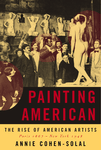|
|
 |
|
|
 |
|
|
 |
 |
 |

|
Shortly after the Civil War, a resurgent America
strode brashly onto the hallowed ground of the Paris
salon to present its most distinguished painters in
the Exposition Universelle of 1867. Their offereings
included majestic Western waterfalls, magnificent
portraits, sprawling landscapes--the cream of a
nation ready to assert itself culturally as it had
begun to do so economically. The Americans sat back
to bask in anticipated applause.
But their
confidence would be shattered when the luminaries of
the French Academy condemned the spectacle as being
unworthy of the great nation that had produced it.
The rebuke provoked widespread soulsearching in
America: Why was the land of Melville and Poe unable
to produce paintings of comparable power? How was it
to claim a place among nations producing art of real
consequence?
In this magnificent historical
panorama, Annie Cohen-Solal shows how American
pragmatism furnished the solution: Learn from the
best. The French were then the undisputed masters of
painting, and so to France the Americans went in
hordes, apprenticing themselves in the studios of
reknowned masters--Gérôme, Cabanel, and
others--or founding colonies such as the legendary
one at Pont-Aven. From the seeds of their individual
efforts would grow an extraordinary crop, one that
included not only the great--Whistler, Cassatt,
Sargent--but a legion of artists of all ranks who
collectively pushed forward a bold new American
enterprise. In two generations, Paris would be
eclipsed, and the greatest French artists would
begin coming to New York to be at the new center of
everything.
Meticulously researched and
presented as a captivating story, this book tells
the saga of the rise of American artists as we have
never had it before: a surging transatlatic ebb and
flow of cultural energies, driven by innumberable
fascinating individuals--painters, collectors,
critics, titans of industry--some of them now
famous, others forgotten. Informed throughout by the
author's unique perspective as a scholar, a writer,
and a cultural diplomat, Painting American
offers an utterly new understanding of one of the
greatest changes in cultural history.
"Annie Cohen-Solal writes with the confident authority and mesmerizing observations of a modern-day de Tocqueville. With one brilliantly argued point after another, she has connected the two worlds of American and French (European) painting, exposed the obvious differences and demonstrated their utter independence. Though it reads like a page-turning detective novel, it is destined to remain the seminal work on this subject for a very long time. Bravo." --Ken Burns
"'The imagination is not dead,' Alexis de Tocqueville observed of America more than a century ago, but it can only 'conceive what may be useful and portray what is actual.' His worry that a country without an aristocracy would be incapable of producing great art has finally been dispelled in Annie Cohen Solal's masterful study of the foundations and flowering of American painting. Her book demonstrates brilliantly that in a democracy of desire artistic beauty blossoms forth in all modes of expression." --John Patrick Diggins, Distinguished Professor of History, Graduate Center, City University of New York
"A thoughtfully conceived, well-executed study of France's influence on American art--and vice versa.... Literate, accessible, and a pleasure to read: worthy to stand on a shelf next to Roger Shattuck's The Banquet Years and Robert Hughes's The Shock of the New."--Kirkus Reviews
"This book, which relates the story of American art since the middle of the nineteenth century, is without equal both in France and in the United States." --Bernard Pivot, "Bouillon de Culture", Antenne 2, Paris, November 24, 2000
|
|
 |
|
|
|
